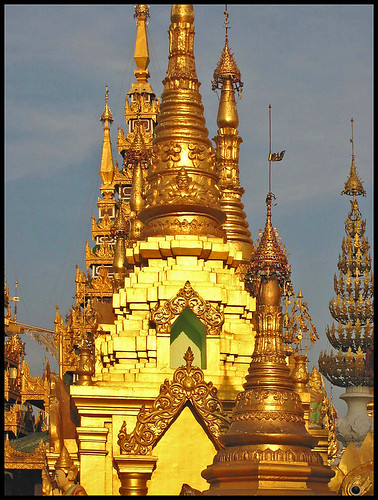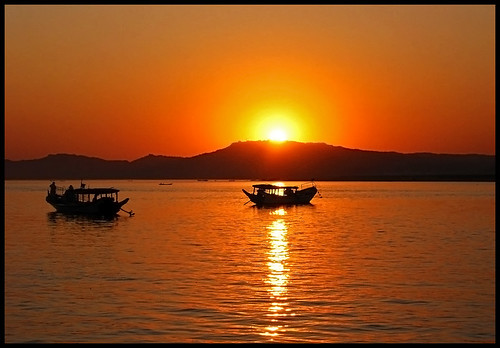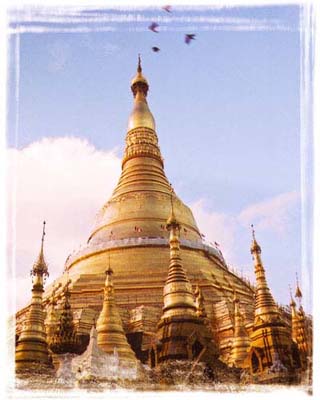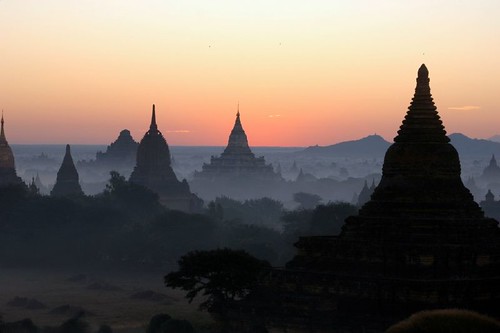WHERE IS MYANMAR?
Surely by now, that we are in the 21st century, half of the world will have been renamed. Old countries with new names appear all over Africa and Asia. Since 1989, Burma has become Myanmar and its capital, Rangoon, has become Yangon, Pegu has become Bago, Maymyo has become Pyin-Oo-Lwin, and so on. Myanmar, also known as the Golden Land, not only for its golden pagodas but also for the wealth of its agriculture and its precious minerals is - with its total area of 676,577 sq.km - about the size of the United Kingdom and France combined. It lies in South East Asia, with parts of India and Bangla Desh to the west, China to the north and Laos and Thailand to the east. Its southern borders are formed by the sea; by the Bay of Bengal to the southwest and the Andaman Sea to the southeast. However, whatever you call it, Myanmar or Burma, as Somerset Maugham once wrote: "You try to guard yourself by saying it is not real... it is a beauty that batters you and stuns you and leaves you breathless..."

People: The population of Myanmar, spread over seven states and seven divisions, is estimated at 48 million people. Myanmar is inhabited by 135 ethnic nationalities. The Bamars, comprising about 69 % of the population, form the largest group.

Religion: Theravada Buddhism is the predominant religion, with 80 percent of the population embracing it. There are also Christians, Muslims and Hindus.
Culture: Buddhism has great influence on daily life of the Myanmars. The people have preserved tradition of close family ties, respect for the elders and reverence for Buddhism. Myanmars are known for their hospitality and friendliness.

History: Myanmar’s Golden Age dates back to the 11th century when King Anawrahta united the whole country into the First Myanmar Empire in Bagan well before the Norman conquest of England in 1066. The Bagan Empire encompassed the entire Menam valley in Thailand and lasted about 250 years, before it collapsed with the invasion of the Mongols under the leadership of Kublai Khan in the 13th century. The Second Myanmar Empire was founded in the middle 16th century by King Bayinnaung. King Alaungpaya founded the Third Myanmar Empire in 1752. It was during the zenith of the Konbaung dynasty, that the British colonized Myanmar. Myanmar became a sovereign state on January 4, 1948, after gaining independence from Britain.

Visa: Tourist and business visas are valid for 28 days. Tourist visas are not extendible; business visa may be extended for another 28 days. Transit visas are valid for 24 hours. Apply to any of Myanmar's embassies or consulates with three photos and your passport.

Vaccinations: None are required unless travelers arrive from infected areas.
Currency: The currency in Myanmar is the Kyat (pronounced 'chaat'). US$ (only new notes) are the accepted currency in Myanmar. It is quite inconvenient to change other foreign currencies as well as to use credit cards and traveller checks. It is possible, but costs commission fees and it takes sometimes up to 2 hours to obtain the cash.


Time: Myanmar’s time is six hours and thirty minutes ahead of Greenwich Meridian Time (GMT).

Airport Tax: When leaving Myanmar by air, an airport tax of US$ 10.- p.p. must be paid before check-in.
Dress: Cotton clothing and a light wrap on evenings during the winter season (between Oct and Feb) are recommended. When visiting temples, pagodas or other places of religious worship, it is necessary to dress modestly, as any kind of revealing clothing is frowned upon in Myanmar. Removal of all footwears and socks is necessary before entering all places of religious worship.

Climate: Myanmar enjoys a tropical climate with three distinct seasons. The wet season lasts from mid-May to mid-October, the dry cool season from mid-October to mid-February, and the warm season from mid-February to mid-May.
Temperatures:
KAYIN STATE
* Hot season: Average temperature is over 80 ºF (26.6 ºC); in the north, maximum temperature is about 90 ºF (32.2 ºC).
* Cold season: Average temperature is over 60 ºF (15.5 ºC); maximum temperature is 40 ºF (4.4 ºC).
SHAN STATE
* Cold season (Dec, Jan): Average temperature is below 64 F (18 ºC).
* April, May, June, July: Average temperature is between 70 F (21 ºC) and 80 ºF (26.7 ºC).

MANDALAY DIVISION
* At the plateau: Average temperature in April is between 70 ºF (21 ºC) and 75 ºF (24 ºC).
* Cold season: Average temperature is below 60 ºF (15.6 ºC).
* Minimum temperature of cold season: Between 32 ºF (0 ºC) and 40 ºF (4.4 ºC).
* In the plain area: Average temperature in the hot season is about 88 ºF. Afternoon temperature is between 105 ºF and 110 ºF and the average temperature in the cold season is about 70 ºF ; minimum temperature is about 50 ºF.
CHIN STATE
* Hot season: Average temperature is between 60 ºF (15.5 ºC) and 70 ºF (21 ºC).
* Cold season: Average temperature is about 40 ºF.
KAYAH STATE
* Hot season: Average temperature is 77.4 ºF (25 ºC).
* Cold season: Average temperature is 62.6 ºF (17 ºC).
Surely by now, that we are in the 21st century, half of the world will have been renamed. Old countries with new names appear all over Africa and Asia. Since 1989, Burma has become Myanmar and its capital, Rangoon, has become Yangon, Pegu has become Bago, Maymyo has become Pyin-Oo-Lwin, and so on. Myanmar, also known as the Golden Land, not only for its golden pagodas but also for the wealth of its agriculture and its precious minerals is - with its total area of 676,577 sq.km - about the size of the United Kingdom and France combined. It lies in South East Asia, with parts of India and Bangla Desh to the west, China to the north and Laos and Thailand to the east. Its southern borders are formed by the sea; by the Bay of Bengal to the southwest and the Andaman Sea to the southeast. However, whatever you call it, Myanmar or Burma, as Somerset Maugham once wrote: "You try to guard yourself by saying it is not real... it is a beauty that batters you and stuns you and leaves you breathless..."

People: The population of Myanmar, spread over seven states and seven divisions, is estimated at 48 million people. Myanmar is inhabited by 135 ethnic nationalities. The Bamars, comprising about 69 % of the population, form the largest group.

Religion: Theravada Buddhism is the predominant religion, with 80 percent of the population embracing it. There are also Christians, Muslims and Hindus.
Culture: Buddhism has great influence on daily life of the Myanmars. The people have preserved tradition of close family ties, respect for the elders and reverence for Buddhism. Myanmars are known for their hospitality and friendliness.

History: Myanmar’s Golden Age dates back to the 11th century when King Anawrahta united the whole country into the First Myanmar Empire in Bagan well before the Norman conquest of England in 1066. The Bagan Empire encompassed the entire Menam valley in Thailand and lasted about 250 years, before it collapsed with the invasion of the Mongols under the leadership of Kublai Khan in the 13th century. The Second Myanmar Empire was founded in the middle 16th century by King Bayinnaung. King Alaungpaya founded the Third Myanmar Empire in 1752. It was during the zenith of the Konbaung dynasty, that the British colonized Myanmar. Myanmar became a sovereign state on January 4, 1948, after gaining independence from Britain.

Visa: Tourist and business visas are valid for 28 days. Tourist visas are not extendible; business visa may be extended for another 28 days. Transit visas are valid for 24 hours. Apply to any of Myanmar's embassies or consulates with three photos and your passport.

Vaccinations: None are required unless travelers arrive from infected areas.
Currency: The currency in Myanmar is the Kyat (pronounced 'chaat'). US$ (only new notes) are the accepted currency in Myanmar. It is quite inconvenient to change other foreign currencies as well as to use credit cards and traveller checks. It is possible, but costs commission fees and it takes sometimes up to 2 hours to obtain the cash.


Time: Myanmar’s time is six hours and thirty minutes ahead of Greenwich Meridian Time (GMT).
Airport Tax: When leaving Myanmar by air, an airport tax of US$ 10.- p.p. must be paid before check-in.
Dress: Cotton clothing and a light wrap on evenings during the winter season (between Oct and Feb) are recommended. When visiting temples, pagodas or other places of religious worship, it is necessary to dress modestly, as any kind of revealing clothing is frowned upon in Myanmar. Removal of all footwears and socks is necessary before entering all places of religious worship.

Climate: Myanmar enjoys a tropical climate with three distinct seasons. The wet season lasts from mid-May to mid-October, the dry cool season from mid-October to mid-February, and the warm season from mid-February to mid-May.
Temperatures:
KAYIN STATE
* Hot season: Average temperature is over 80 ºF (26.6 ºC); in the north, maximum temperature is about 90 ºF (32.2 ºC).
* Cold season: Average temperature is over 60 ºF (15.5 ºC); maximum temperature is 40 ºF (4.4 ºC).
SHAN STATE
* Cold season (Dec, Jan): Average temperature is below 64 F (18 ºC).
* April, May, June, July: Average temperature is between 70 F (21 ºC) and 80 ºF (26.7 ºC).

MANDALAY DIVISION
* At the plateau: Average temperature in April is between 70 ºF (21 ºC) and 75 ºF (24 ºC).
* Cold season: Average temperature is below 60 ºF (15.6 ºC).
* Minimum temperature of cold season: Between 32 ºF (0 ºC) and 40 ºF (4.4 ºC).
* In the plain area: Average temperature in the hot season is about 88 ºF. Afternoon temperature is between 105 ºF and 110 ºF and the average temperature in the cold season is about 70 ºF ; minimum temperature is about 50 ºF.
CHIN STATE
* Hot season: Average temperature is between 60 ºF (15.5 ºC) and 70 ºF (21 ºC).
* Cold season: Average temperature is about 40 ºF.
KAYAH STATE
* Hot season: Average temperature is 77.4 ºF (25 ºC).
* Cold season: Average temperature is 62.6 ºF (17 ºC).
text taken from myanmartravel.net



 2:37 AM
2:37 AM
 crkota
crkota


 Posted in:
Posted in: 

1 comments:
All the photos are looking fantastic, and enough to attract people to visit again and again.
This post is helpful for me know about the Myanmar tours and holidays in a better way. Thanks
Post a Comment